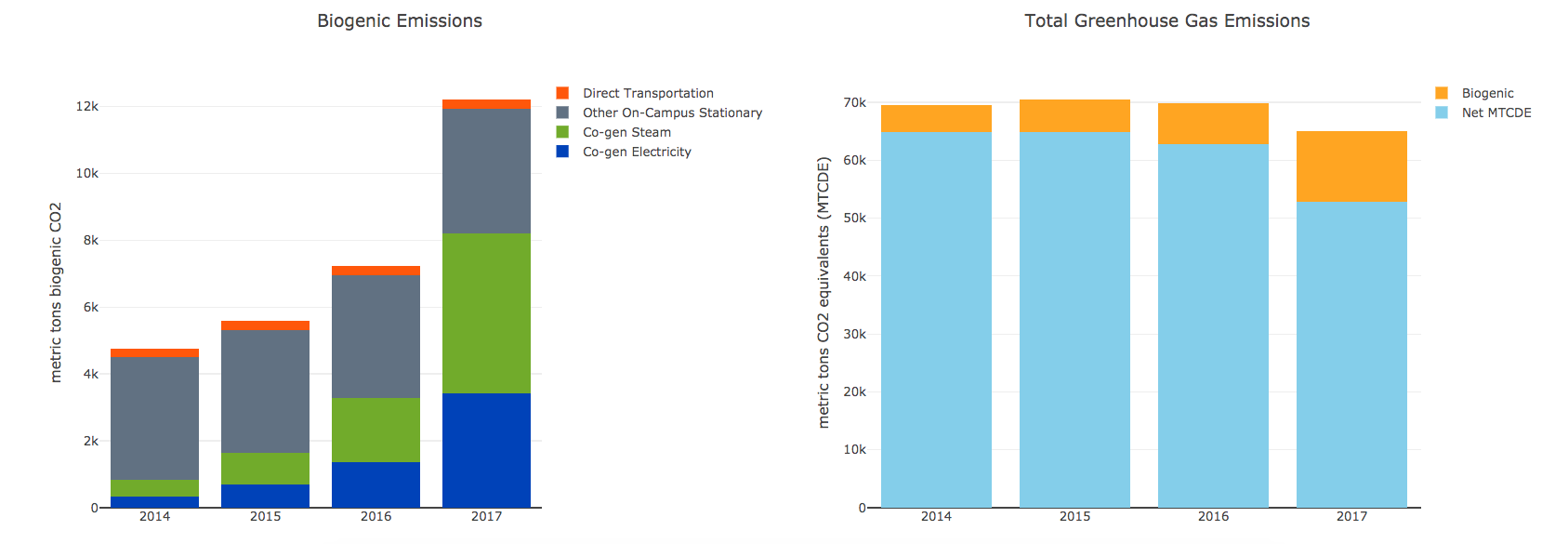What are biogenic emissions?
Biogenic CO2 refers to carbon in wood, paper, grass trimmings, and other biofuels that was originally removed from the atmosphere by photosynthesis and, under natural conditions, would eventually cycle back to the atmosphere as CO2 due to degradation processes. Following the GHG Protocol guidelines, SIMAP separates out biogenic emissions of carbon and considers these emissions to be carbon neutral. This means that biogenic emissions are not added to your net greenhouse gas footprint. However, we strongly recommend (again, in keeping with the GHG Protocol) that you also include your biogenic emissions footprint in your reporting as a best practice for completeness and transparency.
How should I use the biogenic emissions report?
The biogenic emissions report can be viewed on the reports tab. First, select the biogenic emissions report from the report type drop-down:

Once you input a year range and select the campuses you would like to include (applicable for Tier 2 only), you can view your results. The biogenic report includes graphs of the biogenic emissions by category and the total footprint, split into net greenhouse gas emissions and biogenic emissions:

In this example, the use of biogenic sources increases significantly at a cogen facility to offset fossil fuels. In the graph on the right, you can see that the net greenhouse gas footprint decreases over time, while the biogenic emissions footprint increases. Your net greenhouse gas footprint is still the same.
Where else can I view the biogenic emissions results?
The biogenic footprint can only be viewed 'total footprint' results and reports view. This follows guidelines from the GHG Protocol: Biogenic emissions are a category that should be tracked separately from the net greenhouse gas footprint and separately from the footprint by category or scope. The same is true for other footprint calculations that only apply to the total footprint (e.g., sinks, offsets, compost). The biogenic emissions can also be viewed in the biogenic report. Here is a full list of result and report views with biogenic emissions included:
- Results tab > Gross footprint view
- Results tab > Net footrpint view
- Results tab > Sources view
- Reports tab > Annual report
- Reports tab > Biogenic report
How is the biogenic footprint calculated?
With the release of the SIMAP 2020 version of emission factors, biogenic emission factors can now be viewed and customized. Previously, biogenic emissions were calculated "behind the scenes" and could not be customized. You can view the biogenic emission factors by selecting "biogenic" from the emission type drop-down on the emission factors page.
We calculated the biogenic emission factors as a percentage of the CO2 emission factors for all relevant biogenic sources. The following biogenic percentages were used in the SIMAP calculations for biogenic emission factors:
- Wood chips, wood pellets, and grass pellets: 100% biogenic
- Residual bioheat and distillate bioheat: 20% biogenic (note - this is a correction; this was previously 100%)
- B100: 100% biogenic
- E85: 74% biogenic (note - this was updated to reflect the US average; this was previously 85%)
- B20: 20% biogenic
- B5: 5% biogenic
- Incinerated waste: 53% biogenic
- Ethanol: 100% biogenic
Please note that we only currently calculate biogenic emissions for the activities we have categorized under scope 1 sources. In a future update, we will provide biogenic emission factors for the activities categorized under scope 2 purchased electricity and scope 3 sources. Please contact us at simap@unh.edu with any questions.
Will this affect my carbon neutrality goal? Does this include campus land management?
Biogenic emissions will not affect your net greenhouse gas footprint. Following guidelines from the GHG Protocol, biogenic emissions continue to be considered carbon neutral. However, the GHG Protocol does recommend that you report your biogenic emissions for a comprehensive and transparent report.
This report does not address campus land management.
Soon, we will be releasing two additional reports:
- Campus lands report
- Carbon neutrality report
Are there any other changes or updates for biogenic?
We corrected an issue in the 2017 and 2018 version of emissions factors. The 2019 version of emission factors did not have this issue. For the 2017 and 2018 emission factor versions, biogenic emissions were being double-counted. This means that the biogenic emissions were being subtracted twice from the total CO2 emissions (non-biogenic CO2 + biogenic CO2), resulting in a CO2 emissions factor that was too low. If you are continuing to use the 2017 or 2018 version of emission factors, then you may see higher CO2 emissions from mixed biofuels (residual bioheat, distillate bioheat, E85, B20, B5, and incinerated waste). Please note that the 2017 and 2018 versions of emission factors are out of date and are no longer recommended. We recommend updating to the 2020 version of emission factors.
Stay tuned for more! As always, contact us at simap@unh.edu with any questions.

